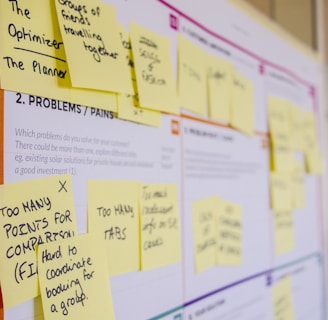Driving Innovation Through Continuous Experimentation: From Vision to MVP to Market Success
From Idea to Market the agile way: why innovation is not a one way process and the importance to test the concept and learn from it.
Felipe Garrido | Spyra Strategy
7/1/20253 min read


Innovation isn’t a straight line — it’s a cycle of learning, testing, and improving. The companies that lead markets today are not those with the biggest ideas, but those that can move from idea to action quickly, measure results, and adapt based on real feedback.
In today’s fast-changing world, continuous experimentation is how organizations stay relevant, resilient, and ahead of competitors.
1. Start with a Real Problem — and Define the Impact
Every great innovation begins with a clear problem to solve. But the key is defining it with measurable business impact.
Ask:
What pain point are we addressing for customers or internal teams?
What value will solving it create — more revenue, lower costs, better experience?
How will we measure success?
Example:
A bank wants to improve account opening rates. Instead of launching a full new platform, they define the problem: “It takes too long for customers to open an account, leading to high drop-offs.” The impact is measurable — conversion rate.
With this clarity, the team can build solutions that directly link to business results.
2. Set a Clear Vision, Then Start Small
Once you know the problem and the goal, set a clear innovation vision — a direction that unites teams around what success looks like.
Then, instead of aiming for a “perfect” product, start small. Create a Minimum Viable Product (MVP) — the simplest version that delivers value and can be tested quickly.
Example:
Airbnb’s founders didn’t start with a global platform. Their MVP was renting out air mattresses in their apartment to test if people would pay to stay in someone’s home.
That small experiment validated a big idea — and became a multibillion-dollar business.
3. Deploy Fast, Learn Faster
Speed matters. The faster you launch an MVP, the faster you collect data, feedback, and insights.
Use agile methods — short development cycles, daily collaboration, and iterative releases — to keep progress moving and avoid long development timelines that miss market shifts.
Example:
Tech startups like Spotify and Netflix constantly run A/B tests to understand user behavior. Instead of one big release, they run hundreds of micro-experiments each month, learning what customers want in real time.
This approach keeps innovation alive and ensures every improvement is backed by real data.
4. Measure What Matters
Once your MVP is in the market, track the metrics that reflect real impact.
Key indicators might include:
User adoption or engagement
Conversion rates or revenue lift
Customer satisfaction (NPS)
Operational efficiency gains
Avoid vanity metrics — focus on measurable outcomes that prove the concept works.
Example:
A retailer testing AI-driven product recommendations might measure average order value and repeat purchase rate to gauge success.
5. Learn, Adapt, and Iterate
Not every idea will succeed — and that’s the point. The most innovative companies are those that learn fast and recover faster.
Every experiment, successful or not, brings valuable insight. Use that learning to refine your product, service, or business model in the next cycle.
Example:
Amazon famously embraces a “Day 1” culture — an approach that keeps the company in a constant state of experimentation and reinvention. Failures aren’t punished; they’re seen as steps toward improvement.
This culture of iteration is what allowed Amazon to evolve from an online bookstore to a cloud and AI powerhouse.
6. Build a Culture That Supports Experimentation
Processes alone won’t drive innovation — people and culture will. Encourage teams to question assumptions, test bold ideas, and share learnings openly.
Leaders must create a safe space for experimentation, where mistakes are treated as learning opportunities rather than failures.
Example:
Google’s “20% time” policy, which encouraged employees to spend part of their time on personal innovation projects, led to the creation of Gmail and Google News.
When teams feel empowered to test and learn, innovation becomes a habit — not a one-time event.
The Continuous Innovation Cycle
Innovation is not a project — it’s a continuous cycle that repeats as your organization evolves:
Define a problem with measurable impact
Set a vision aligned with business goals
Build and launch an MVP quickly
Measure performance and gather feedback
Adapt and iterate to improve results
Scale what works across the organization
This ongoing loop keeps companies responsive, customer-focused, and future-ready.
Final Thought
Innovation is not about perfection — it’s about progress through experimentation. The faster you can test, learn, and adapt, the faster you can turn ideas into impact.
Let's Talk
At Spyral Strategy, we help businesses accelerate innovation the agile way — from defining the right problems to designing, testing, and scaling MVPs that deliver real results.
Whether you’re reimagining a product, process, or customer experience, our team can guide you through the full innovation cycle — from vision to market success.
👉 Get in touch with Spyral Strategy today and start transforming ideas into measurable growth.
© 2025 Spyral LLC — Strategy | Innovation | Digital Transformation | CX | Growth | Capital Investments. All rights reserved.
Coral Gables, FL
Serving the U.S., Latin America and Global Markets
